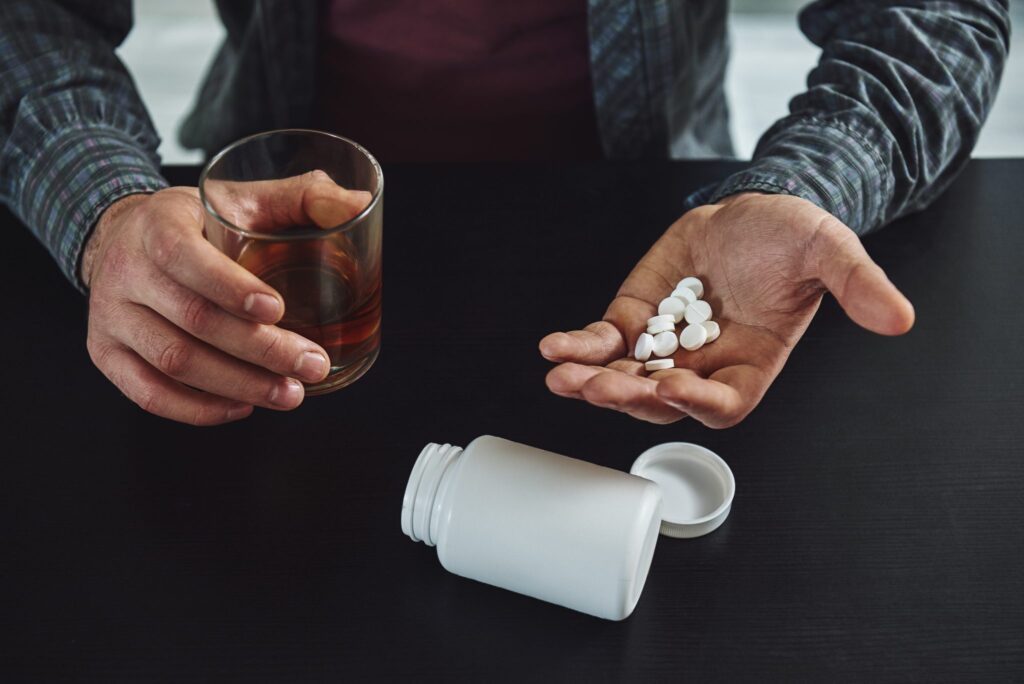Alcohol is a substance that is widespread in our culture. Most can enjoy it recreationally, but others struggle with its addictive qualities. I’ll suspend all moral judgments throughout this article and instead focus on how this drug can interact with some of the medications we offer at my clinic. The medications to be examined are GLP-1 receptor agonists. GLP-1 receptor agonists (GLP-1RAs) are some of the most popular weight loss drugs on the market. They’re commonly known by their recent chemical iterations: semaglutide and tirzepatide. These are the medications we use at Steel Health and Hormones Centre, my HRT and medical weight loss clinic with locations in Delmont and Wexford, Pennsylvania. I’ll use GLP-1RAs for brevity, but understand that when I’m interjecting my personal experience, it will be in reference to semaglutide and/or tirzepatide. This article will explore the interaction between alcohol consumption and GLP-1RAs in relation to tissue loss (used interchangeably with weight loss in this article). I’ll bring in the latest research on this topic as well as my personal experience running my medical company.
Additionally, I want to preface this blog post by stating that I am not a doctor. While I am the owner of Steel Health and Hormones Centre and this article is well-researched, it is not to take the place of the care of your doctor. This article is not meant to diagnose, treat, or prevent disease. This article is also not meant to alter your therapy already assigned to you by your doctor. This article is for informational purposes only. If you’re interested in any medical advice or therapy, it should be done under the strict care of a doctor. If you don’t have a doctor knowledgeable in HRT and medical weight loss, then please fill out a contact form at the bottom of the page, and we would be happy to help you.
History and Mechanism of Action
GLP-1RAs were originally developed as a second-line therapy for individuals suffering from Type II Diabetes. The original GLP-1RAs were short-lived and required frequent injections. They were stacked with drugs like metformin to help with glycemic control (stable blood sugar) and weight loss. Modern-day GLP-1RAs are more powerful on a milligram basis and require less frequent injections. As the medication has become more widespread, they’ve taken on a role outside of glycemic management in diabetes and are commonly used for weight management. In our clinic, we use GLP-1RAs semaglutide and tirzepatide. We’ve seen great success with these medications, especially paired with lifestyle changes and hormone optimization.
GLP-1RAs work on three related but distinct systems: the pancreas, gastrointestinal tract, and central nervous system. GLP-1RAs bind to the GLP-1 receptors of the pancreas and cause enhanced insulin release and inhibited glucagon release, which results in lower blood sugar and a low risk of hypoglycemia (low blood sugar). This “leveling out” of the blood sugar is the definition of glycemic control, but it also has the added benefit of preventing excess eating from the sensation of low blood sugar (feeling weak, tired, “shaky,” and hungry).
These medications work on the gastrointestinal tract by slowing down gastric emptying (the rate at which the food goes from one end to the other). This delayed rate of gastric emptying means that the same meal takes longer to digest, which can lead to less hunger and fewer spikes in blood sugar.
The medication works on the central nervous system in ways not entirely understood. Recent research suggests that the long half-life of current GLP-1RAs allows them to reach deep into areas of the brain that the body’s natural GLP-1 would not have the biological half-life to reach. Mice research shows that GLP-1 activation in the brain suppresses appetite and other addictive behaviors like alcohol and cocaine use. Some researchers believe that appetite suppression is entirely caused by GLP-1 receptors being activated in the brain.
My personal experience tells me that there is evidence of all three mechanisms resulting in glycemic control and weight loss. When I did my tirzepatide experiment, I found that I didn’t get
the same tiredness I usually felt after a meal. This could be a result of simply eating less (more on this later), or it could be a result of a more controlled and sustained insulin release. I also dealt with constipation. Again, the constipation could be a result of simply having less intestinal mass (food) in my stomach, or it could be a result of slower GI emptying. From a neurological perspective, I found that cravings across the board were tamped down substantially. I found that while taking tirzepatide, I had almost no nicotine cravings. Overall, it’s possible that the glycemic control and GI elements are a result of consuming less food; however, I believe it’s reasonable to conclude that the activation of GLP-1 in the other systems has independent effects. Over the course of my 4-week tirzepatide experiment, I lost 8 pounds.
Enter Alcohol
My snuffing out of nicotine cravings seems to coincide with the literature. Recent literature shows that GLP-1RAs seem to tamp down cravings for drugs and alcohol in mice and non- human primates. Researchers believe this has something to do with dopamine (the reward chemical) in the brain, but the process is not well understood. While we don’t use GLP-1RAs for substance abuse disorder, some researchers are examining these drugs for exactly that purpose.
Before we get into my speculation, I want the reader to understand several obvious points about alcohol. First, it lowers inhibitions. We’ve all said and done things we’ve regretted, and those situations seem to compound when alcohol is introduced into the mix. We’ve all had a dessert we otherwise would have foregone after several drinks. Alcohol is also almost always consumed as a liquid, which means it can be consumed quickly and without the typical chewing that comes with food. Alcohol also has the ability to lower blood sugar and potentially cause hypoglycemia.
The final fact people must understand before I begin my speculation is the first law of thermodynamics and how it relates to weight loss. Energy cannot be created or destroyed. Calories and body fat are forms of energy. If you want to lose body fat, you must create an energy deficit in your daily energy demands. As an example, if you burn 2000 calories per day, you need to consume less than 2000 calories of food for your body to draw from its own energy stores (body fat). GLP-1RAs do not bend the laws of thermodynamics; they simply make it easier to maintain a calorie deficit. The exception to this is that a patient may lose or gain weight in the opposite direction of their calorie consumption, but this is usually a result of fluctuations in water retention, and not a result of a change in stored energy (tissue). I’ve been using weight loss colloquially, but what I mean formally is tissue loss.
Speculation
While the research and my personal experience tell me that GLP-1RAs may lower cravings for drugs and alcohol, I find the effect on weight loss to be less cut-and-dry. We find that some patients who have a dysfunctional relationship with alcohol tend to require a larger dose to
achieve the desired weight loss that we see in other patients. Below will be a combination of well-supported facts and speculation. I will make the distinction as clear as possible. My speculation will be italicized to clarify.
Lowered Inhibitions
It is well understood in the literature that alcohol can lower inhibitions. It is also well-researched that part of eating for weight loss is to forgo foods that are calorie-dense or to modulate portions to maintain a calorie deficit. Doing what you have to do instead of doing what you want to do is the definition of cognitive inhibition. If a patient is on a GLP-1RA to lose weight, they still must maintain a calorie deficit. If cognitive control is inhibited, there is a theoretical possibility that a patient may make choices that push them out of a calorie deficit.
Feeling of Satiety
Research suggests that chewing impacts the feeling of satiety. As a person in the fitness industry, my experience tells me this is true. I find that sheer volume of food seems to impact satiety even when calories are consistent. Alcohol is almost always consumed in the form of a liquid, bypassing an important modulator of hunger. It’s possible that the patient is consuming more calories than they otherwise would have while drinking because important signals for fullness are being bypassed. This additional calorie consumption may push the patient outside of a calorie deficit.
Lowered Blood Sugar
It’s well established in the research that alcohol can lower blood sugar. As we’ve discovered earlier, GLP-1RAs will impact insulin release in the pancreas. Therefore, it’s possible that these medications can compound. The resulting low blood sugar can make people feel hungry, resulting in more food than would have otherwise been consumed. This could also potentially result in the patient being outside of a calorie deficit.
It’s possible that none of these are a result of my anecdotal experience of resistance to weight loss in patients who consume alcohol. It’s also possible that it’s a contribution of all of the above. Much of this is my speculation. Overall, I believe GLP-1RAs are fantastic medications for weight loss, and they work exceptionally well when combined with exercise, conscious eating, and hormone optimization.
If you’re somebody in the Murrysville area who is interested in a white-glove approach to hormone replacement therapy and medical weight loss, please reach out to us by filling out a contact form below.
Overview
GLP-1RAs are a class of drugs that work on the pancreas, gastrointestinal tract, and central nervous system to aid in weight loss. They can help a patient maintain a calorie deficit, but they will not bend the laws of nature to assist in tissue loss. A calorie deficit must still be maintained. Research suggests GLP-1RAs can reduce cravings for drugs and alcohol by their action on the CNS.
Alcohol may have special qualities that make it harder to maintain a calorie deficit. If alcohol prevents a calorie deficit, GLP-1RAs will not result in weight loss.
Sources
- https://pubmed.ncbi.nlm.nih.gov/26371721/
- https://www.theatlantic.com/health/archive/2024/03/ozempic-glp1-weight-loss-brain-gut/ 677645/
- https://www.ncbi.nlm.nih.gov/pmc/articles/PMC8820218/
- https://www.mountsinai.org/health-library/selfcare-instructions/diabetes-and-alcohol#:~ =Diabetes and the Risks of Drinking Alcohol&text=While your liver is processing,cause seriously low blood sugar.
- https://alcohol.org/health-effects/inhibitions/
- https://www.ncbi.nlm.nih.gov/pmc/articles/PMC9549911/#:~ =Chewing%20may%20enhance%20or%20reduce,healthy%20weight%20women%20(74 ).



